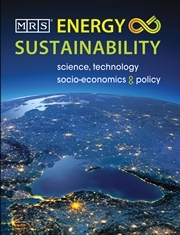Psychologists have long touted the advantages of stepping out of one’s comfort zone. While it is stressful, it pushes one to try new things, to grow and learn. The adage of pushing one’s boundaries decidedly applies to research and academia. Discovery requires taking risks. Science benefits from openness to new, differing ideas. Even ideas that go entirely against the grain of conventional thinking in the world of energy and sustainability.
As a scientific review journal, MRS Energy & Sustainability―A Review Journal enjoys a broader scope than its name might initially indicate. Energy and sustainability are nuanced, complex, and, in the present world, highly politicized fields. As the journal’s editors, we walk a fine line and admittedly take pride in pushing the journal’s limits by encouraging diverse voices and viewpoints.
In our young three-year lifespan, we have strived to publish reputable studies on multidisciplinary topics that cut across the natural and social sciences. While it is part of the MRS banner, inside this journal’s pages are analyses at the intersection of economics, policy, and a range of scientific fields where materials and energy technologies impact global sustainability, as broadly as in public health and the energy-water nexus, etc.
Back in the first volume of the journal, an expert in solar energy and environmental physics presented the technical and economic challenges of introducing renewable energies on a global scale (David Faiman, “Concerning the global-scale introduction of renewable energies: Technical and economic challenges,” DOI: 10.1557/mre.2014.8). In the second volume, an integrative biologist called for a transformation of the global energy system if we are to avoid a mass extinction of terrestrial and marine species (Anthony D. Barnosky, “Transforming the global energy system is required to avoid the sixth mass extinction,” DOI: 10.1557/mre.2015.11). Elsewhere, we presented social ecologists’ vision of how the dominant energy sources used by human societies and the transitions from one source to another impact societal development (Marina Fischer-Kowalski and Anke Schaffartzik, “Energy availability and energy sources as determinants of societal development in a long-term perspective,” DOI: 10.1557/mre.2015.2).
This array of reports is all the better to serve our wide spectrum of readers, which include academics, scientists, policymakers and industry professionals. Our vision is for the journal to be a platform for articles that our readers might not come across in peer-reviewed scientific/technical journals, and that complement existing scientific and technical literature.
Nonetheless, we expect articles to be grounded in fact. We are in some ways an atypical journal where articles are peer-reviewed but need not refer to peer-reviewed scientific literature in order to be published. We respect a diverse set of information sources, from published news articles to government white papers, as long as articles cite a list of such robust sources. Opinion, after all, is different from truth.
We invite you to submit data-backed articles that present distinctive, unique perspectives. By removing boundaries and facilitating interactions between differing scholarly and scientific communities, we hope for our readers to benefit from each other’s wisdom and start dialogues that promote a clearer understanding of energy and sustainability.
May, 2016



